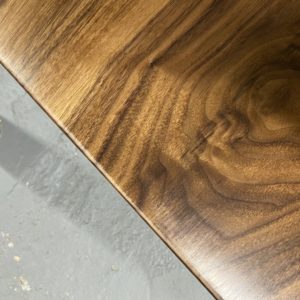Hi all,
I’m having an issue with finishing a walnut coffee table and hoping to get some guidance/help.
Here’s the problem: some of the edges of the coffee table top are showing a pale color around the rim. It’s hard to determine whether this is from sanding or from build up of polyurethane around the rim or something else. I’ve included some pictures of the worst spots.
Here’s the process I followed for finishing the table:
1. Rubbed on and wet sanded (320/400) several coats of Watco Tung Oil blend, wiping off the excess and scuffing with 0000 steel wool in between coats. I waited 24-48 hours between coats and allowed to sit and cure for 2 weeks.
2. Applied 2 coats of dewaxed shellac as a sealer and sanded lightly.
3. Applied 4 coats of Varathane water-based polyurethane, using a nylon brush and sanding (400) lightly in between coats. Typically 24 hours between coats.
The problem I’m seeing started to develop after the 3rd coat of polyurethane. To note, I’m doing this work in my basement, which is on the cooler side here in the northeast.
So far the following possible causes come to mind, though all could be wrong:
1. In sanding, I accidentally sanded through the finish around the edges, so these lines are natural wood showing through. (This feels unlikely, since I never sanded the edges very intensely.)
2. There is some kind of moisture underneath the polyurethane that is starting to show through. (Hopefully this isn’t it.)
3. I applied the polyurethane too thickly and it pooled at the edges of the table. (I thought this might be the case after the lines first appeared, so I sanded more intensely and reapplied the poly – no significant change and may be worse in some spots.)
Looking for any help you may be able to offer in diagnosing and fixing the problem. Thank you!


 Shop Talk Live Podcast
Shop Talk Live Podcast Our favorite articles and videos
Our favorite articles and videos Fine Woodworking New England Event
Fine Woodworking New England Event













Replies
Looks to me like you've rounded the edge by sanding with a soft block or your hand and you are looking at the flat grain / end grain horizon. If I was asked for a "solve", I would chamfer the edges with a block plane and re-sand the top with a stiff sanding block. You should wind up with facets instead of rounded edges.
Looks to me like you sanded through the finish. This has happened to me many times.
As a result I only sand the face and flat edge of the piece of furniture. I don't sand the corners at all until it comes time to wet sand or wax and wool.
Even a soft cotton rag will smooth the edges safely.
It's amazing how easily it is to remove the finish from these vulnerable edge corners. I've removed stain and two topcoats with a few swipes of 400-600 grit. We all need to less aggressive with our finish sanding between coats. This was a hard learned lesson for me.
Just rub a little colored wax on it, and you'll never notice it.
I've used Howard's Walnut wax, and Briwax with success.
Yeah, you wore through the finish at the ends.
Thanks, all. Would it makes sense to just touch up these exposed areas with a little of the tung oil blend so that they appear to be the same shade as the rest of the table?
This forum post is now archived. Commenting has been disabled